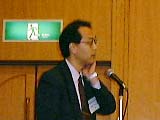![]()
| S-9-5 Proteoglycans (PGs) in the infarcted and the pressure-overloaded hearts. |
| T. Murakami1, S. Kusachi1, Y. Ninomiya2, T. Tsuji1 1Depertment of Internal Medicine I and 2Depertment of Molecular Biology and Biochemistry, Okayama University Medical School, Okayama, 700-8558, Japan |

![]()
The topography of the ventricle is altered in various pathological conditions. This alteration, i.e., ventricular remodeling, is now well known to be an independent predictor of mortality in patients with heart diseases. In infarct healing, the sequential changes that occur in the extracellular matrix (ECM) after acute myocardial infarction (AMI) may play an important role in preventing ventricular expansion. PGs have been postulated to interact with other components of the ECM and growth factors. We hypothesize here that expression of PGs increases in the infarcted and pressure-overloaded (PO) hearts. Expression of decorin, biglycan and perlecan were examined in experimentally-induced AMI. Expression of biglycan was also examined in the renovascular PO hearts. In rat AMI model, Northern blotting revealed that biglycan mRNA signals increase on day 2. Decorin mRNA signals appeared later than those of biglycan mRNA, and both of them reached a peak around day 14. The expression pattern of biglycan mRNA is closely correlated to that ofα1(I) collagen mRNA, all of them are expressed by mesenchymal cells (presumably myofibroblasts and fibroblasts). We speculate that the increase in the level of biglycan coincided with the activity of fibrosis, while decorin contributes to ECM homeostasis via a feedback mechanisms involving TGFβ. In mouse AMI model, perlecan mRNA signals increase on day 2 and reached peak around day 7 in the infarct zone, concomitantly with type IV collagen mRNA signals. Immunopositive staining for perlecan, which was observed around infarct granulation tissue, overlapped with bFGF immunostaining. The present results indicate that perlecan contributes to the infarct healing process, at least partly, via modulation of bFGF homeostasis. In rat renovascular PO model, expression of biglycan mRNA was increased up to day 2, then gradually decrease. Increased expression was observed in myocardial interstitial fibroblasts, vascular endothelial cells and smooth muscle cells by in situ hybridization. In conclusion, we demonstrated here in spatially and temporally increased expression of PGs in the post AMI and renaovascular PO hearts. Modification of these PGs expression at appropriate timing may improve ventricular remodeling, which affects long-term prognosis.
![]()